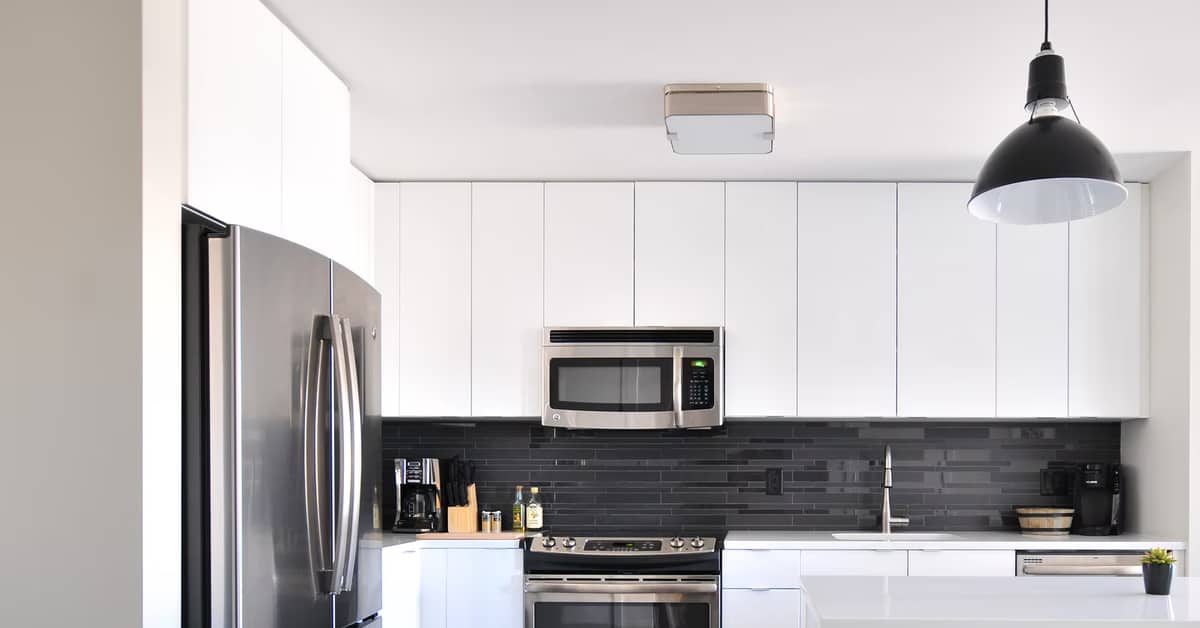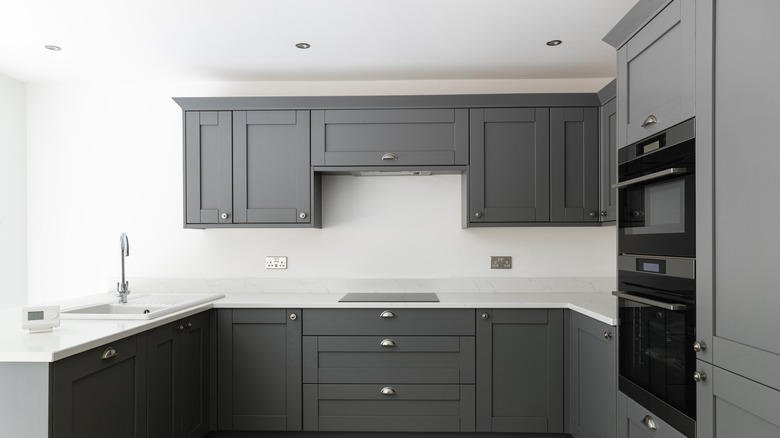Standard Space Requirements

The space between your kitchen cabinets and the ceiling, often referred to as the “cabinet soffit,” is a crucial design element that influences both functionality and aesthetics. While it might seem like a minor detail, the standard space requirements are carefully considered for optimal performance and visual appeal.
The standard space between kitchen cabinets and ceilings typically falls within the range of 12 to 18 inches. This range ensures adequate ventilation, facilitates easy access for cleaning and maintenance, and allows for the integration of lighting fixtures and other essential components.
Benefits of Adhering to Standard Dimensions
Adhering to the standard space requirements offers numerous benefits, including:
- Improved Ventilation: The space between the cabinets and ceiling allows for air circulation, preventing moisture buildup and reducing the risk of mold growth. This is particularly important in kitchens, where cooking generates heat and humidity.
- Enhanced Cleaning Accessibility: The standard space provides ample room for cleaning the top of cabinets, the ceiling, and the space in between. This ensures a hygienic and presentable kitchen environment.
- Aesthetic Appeal: The standard space creates a visually pleasing proportion between the cabinets and the ceiling, contributing to a balanced and harmonious kitchen design.
- Integration of Lighting and Other Features: The space allows for the installation of recessed lighting fixtures, ventilation systems, and other essential components, enhancing the functionality and ambiance of the kitchen.
Space Requirements for Different Kitchen Cabinet Styles
The space requirements may vary slightly depending on the style of kitchen cabinets. Here’s a breakdown of typical space considerations for different styles:
- Modern Kitchen Cabinets: Modern kitchens often feature sleek and minimalist designs with clean lines and a focus on functionality. They typically have a smaller space between cabinets and ceilings, ranging from 12 to 15 inches, to maintain a streamlined aesthetic.
- Traditional Kitchen Cabinets: Traditional kitchens embrace classic designs with intricate details and ornate finishes. They often have a larger space between cabinets and ceilings, ranging from 15 to 18 inches, to accommodate decorative moldings and crown molding, which are common features in traditional styles.
- Contemporary Kitchen Cabinets: Contemporary kitchens combine modern elements with a touch of traditional charm. They may have a space between cabinets and ceilings that falls within the standard range of 12 to 18 inches, depending on the specific design elements and desired aesthetic.
Factors Influencing Space Selection

The decision of how much space to leave between your kitchen cabinets and the ceiling is a matter of both functionality and aesthetics. This space, often referred to as the “reveal,” can significantly impact the overall look and feel of your kitchen. Several factors influence this choice, including the height of your ceiling, the style of your cabinets, and your personal preferences.
Ceiling Height, Space between kitchen cabinets and ceiling
The height of your ceiling plays a crucial role in determining the optimal space between your cabinets and the ceiling.
- Low Ceilings: In kitchens with low ceilings, minimizing the reveal is generally recommended to create an illusion of greater height. A smaller reveal can visually elongate the room and prevent the cabinets from appearing too bulky. For example, a kitchen with an 8-foot ceiling might benefit from a reveal of only 4-6 inches. This can create a sense of spaciousness, especially if the cabinets are painted in a light color.
- Standard Ceilings: Kitchens with standard 8-foot ceilings offer more flexibility in terms of the reveal. A reveal of 6-12 inches can be a good compromise, providing enough space for proper ventilation and lighting while still maintaining a visually appealing aesthetic.
- High Ceilings: High ceilings, on the other hand, allow for a larger reveal. This can create a dramatic effect, adding a sense of grandeur and openness to the kitchen. A reveal of 12-18 inches or even more is possible in such cases, allowing for decorative elements like crown molding or accent lighting.
Cabinet Style
The style of your cabinets also influences the optimal reveal.
| Cabinet Style | Advantages | Disadvantages | Ideal Reveal |
|---|---|---|---|
| Recessed Cabinets | Creates a sleek, modern look; maximizes storage space; visually expands the room | Can make the ceiling appear lower; requires careful planning and installation | 4-8 inches |
| Raised Cabinets | Adds visual interest; creates a sense of height; provides additional storage space above the upper cabinets | Can be more expensive; requires careful planning and installation | 8-12 inches |
| Standard Cabinets | Versatile; easy to install; readily available | May not be as visually appealing as other styles; limited storage space above the upper cabinets | 6-12 inches |
Practical Considerations: Space Between Kitchen Cabinets And Ceiling

The space between your kitchen cabinets and the ceiling, often referred to as the “dead space,” presents a valuable opportunity to enhance your kitchen’s functionality and aesthetics. By strategically utilizing this area, you can maximize storage, improve lighting, and streamline your kitchen’s design.
Maximizing Storage
This space can be transformed into a hidden storage haven. Several methods can be employed to make the most of this often-overlooked area.
- Installing Shelves: Custom-built shelves, crafted to fit the exact dimensions of your kitchen, offer a versatile and adaptable storage solution. These shelves can accommodate a wide range of items, from seldom-used appliances to decorative pieces. You can opt for open shelving for easy accessibility or closed shelving for a more streamlined look.
- Incorporating Pull-Down Storage Solutions: Pull-down storage systems, such as baskets or trays, offer an efficient way to access items stored high up. These systems are typically mounted on tracks and can be easily lowered and raised, making it effortless to retrieve items from the ceiling space.
- Utilizing Decorative Boxes: Decorative boxes can be used to organize and conceal items while adding a touch of style to your kitchen. Choose boxes in colors and patterns that complement your kitchen’s design and label them for easy identification.
Installing Recessed Lighting
Recessed lighting fixtures provide a sleek and efficient way to illuminate your kitchen, offering a clean and modern aesthetic. Installing recessed lighting within the space between cabinets and the ceiling can enhance the overall lighting scheme, highlighting your kitchen’s features and creating a warm and inviting atmosphere.
- Gather Necessary Tools: Before you begin, ensure you have the right tools for the job. This includes a drill, screwdriver, wire strippers, voltage tester, and safety glasses.
- Turn Off Power: Safety is paramount. Before working with electrical wiring, always turn off the power to the circuit at the breaker box.
- Mark and Cut Holes: Determine the desired locations for your recessed lighting fixtures and mark the ceiling with a pencil. Using a hole saw, carefully cut holes in the ceiling to accommodate the fixtures.
- Install Junction Boxes: Install junction boxes within the cut holes, ensuring they are securely fastened to the ceiling. These boxes will house the electrical connections for the fixtures.
- Connect Wiring: Connect the electrical wires from the fixtures to the junction boxes, ensuring proper polarity (black to black, white to white, and ground to ground).
- Install Fixtures: Secure the recessed lighting fixtures within the cut holes, ensuring they are flush with the ceiling.
- Test and Restore Power: Once the fixtures are installed, test them to ensure they are working correctly. Restore power to the circuit at the breaker box.
Space between kitchen cabinets and ceiling – Just like the space between kitchen cabinets and the ceiling can be a source of dust accumulation, a cluttered medicine cabinet can feel like a weight on your mind. Consider a medicine cabinet replacement mirror door to create a sense of order and clarity in your bathroom.
The same way a clean ceiling space in your kitchen can create a sense of spaciousness, a streamlined medicine cabinet can contribute to a more peaceful and organized bathroom environment.
The space between kitchen cabinets and the ceiling can feel like wasted potential. It’s a prime opportunity to create additional storage or to simply add a touch of visual interest. If you’re looking for stylish and functional solutions, consider exploring the possibilities with top kitchen cabinets miami.
These cabinets can be custom-designed to maximize that space, offering a seamless blend of functionality and aesthetics. Whether you choose open shelving, closed cabinets, or a combination of both, the right design can transform that overlooked area into a valuable asset for your kitchen.
